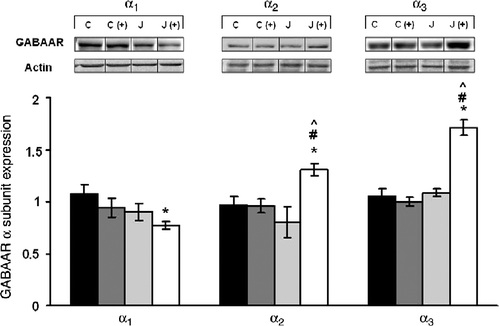Figures & data
Figure 1. Short- and long-term effects of juvenile variable stressor regimen (JUV-S) on exploratory and anxiety behavior in an elevated plus maze. Data were analyzed through a 2 (juvenile stressor vs. no stress) × 2 (age: juvenile vs. adult) between-groups ANOVA followed by HSD Tukey's post-hoc tests. Data are expressed as means ± SEM (n = 8–11/group). Compared with controls, JUV-S rats (A) spent more time in the open arms of the elevated plus maze when tested in juvenility and less time in the open arms of the apparatus when tested in adulthood, (B) were more active in the open arms when tested in juvenility and less active when tested in adulthood, (C) spent less time in the closed arms when tested in juvenility but no differences were observed when tested in adulthood, and (D) were more active in the closed arms when tested in juvenility but these effects were absent when rats were tested as adults; *, represents significantly different from controls, p < 0.05; •, represents significantly different from the same group juveniles, p < 0.05.
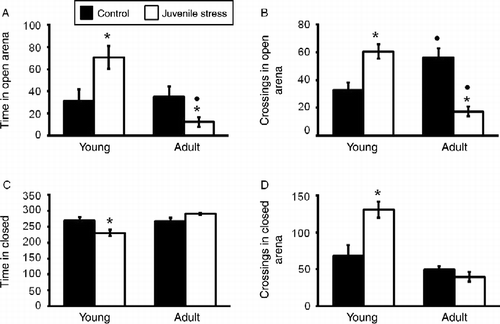
Figure 2. The short-term effects of juvenile variable stressor regimen (JUV-S) on GABAA receptor α subunit expression in the hippocampus. Data were analyzed through a 2 (juvenile stressor vs. no stress) × 2 (age: juvenile vs. adult) between-groups ANOVA followed by HSD Tukey's post-hoc tests. Data are expressed as means ± SEM (n = 8–11/group). Neither the juvenile stressor nor the plus maze experience influenced hippocampal α1 or α2 subunits, whereas α3 subunit expression was elevated in rats that had been stressed as juveniles and then tested in the plus maze relative to control and rats that received either of these treatments alone; *, represents significantly different from controls, p < 0.05; (C) #, represents significantly different from elevated plus maze challenge group C (+), p < 0.05; ^, represents significantly different from juvenile stress group (J), p < 0.05.
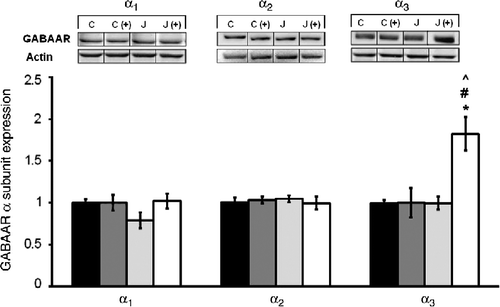
Figure 3. The long-term effects of juvenile variable stressor regimen (JUV-S) on GABAA receptor α subunit expression in the hippocampus. Data were analyzed through a 2 (juvenile stressor vs. no stress) × 2 (age: juvenile vs. adult) between-groups ANOVA followed by HSD Tukey's post-hoc tests. Data are expressed as means ± SEM (n = 8–11/group). GABAA subunit expression assessed among adult rats was very different from that evident in juveniles. In rats that received juvenile stressor and adult plus maze exposure, the expression of the α1 subunit was decreased compared to controls, α2 subunit was elevated relative to rats that had received either the juvenile stressor or the plus maze exposure alone. Finally, expression of the α3 subunit was neither affected by either of the treatments nor their interaction; *, represents significantly different from controls (C), p < 0.05; #, represents significantly different from elevated plus maze challenge group C (+), p < 0.05; ^, represents significantly different from juvenile stress group (J), p < 0.05.
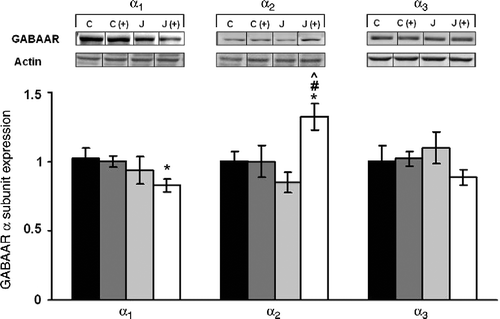
Figure 4. The short-term effects of juvenile variable stressor regimen (JUV-S) on GABAA receptor α subunit expression in the amygdala. Data were analyzed through a 2 (juvenile stressor vs. no stress) × 2 (age: juvenile vs. adult) between-groups ANOVA followed by HSD Tukey's post-hoc tests. Data are expressed as means ± SEM (n = 8–11/group). Among rats that were tested as juveniles, neither the juvenile stressor nor the plus maze test affected either α1 or α3 subunit expression within the amygdala, whereas the juvenile stressor experience reduced α2 to a moderate, but significant extent; *, represents significantly different from controls (C), p < 0.05.
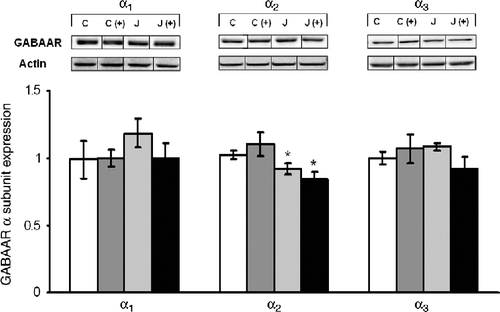
Figure 5. The long-term effects of juvenile variable stressor regimen (JUV-S) on GABAA receptor α subunit expression in the amygdala. Data were analyzed through a 2 (juvenile stressor vs. no stress) × 2 (age: juvenile vs. adult) between-groups ANOVA followed by HSD Tukey's post-hoc tests. Data are expressed as means ± SEM (n = 8–11/group). More dramatic effects on amygdala subunit expression were apparent in rats tested in adulthood. Among rats that had initially been stressed as juveniles and then exposed to the adult stressor, the levels of α2 and α3 were significantly increased while those of α1 were decreased. Nevertheless, neither the juvenile stressor experience nor the plus maze test alone elicited a change of these receptor subunits; *, represents significantly different from controls (C), p < 0.05; #, represents significantly different from elevated plus maze challenge group C (+), p < 0.05; ^, represents significantly different from juvenile stress group (J), p < 0.05.
